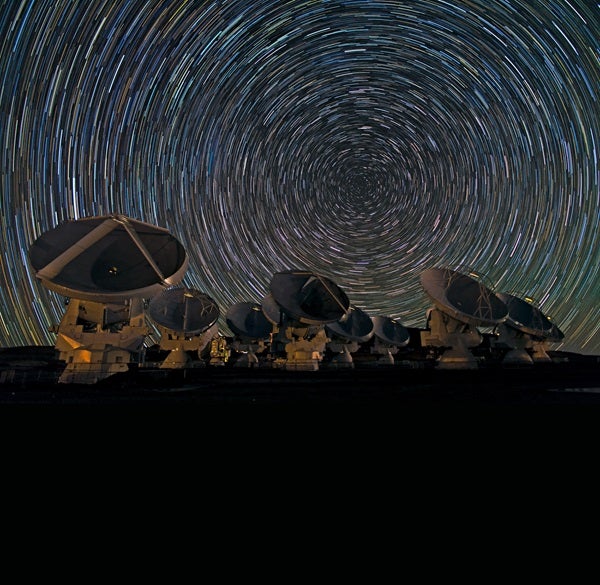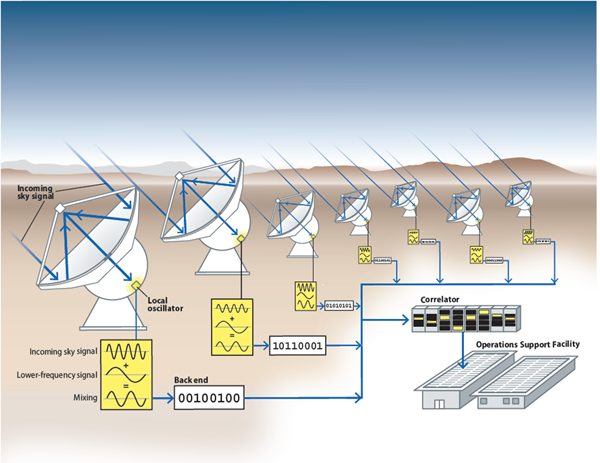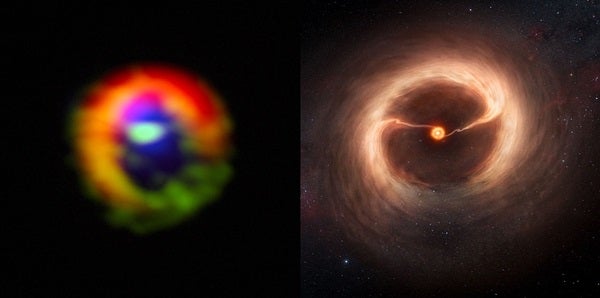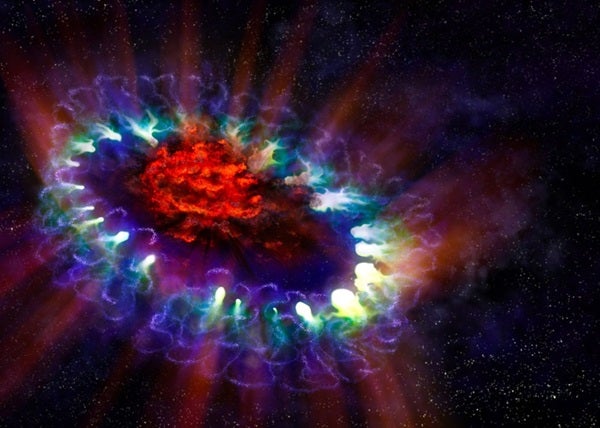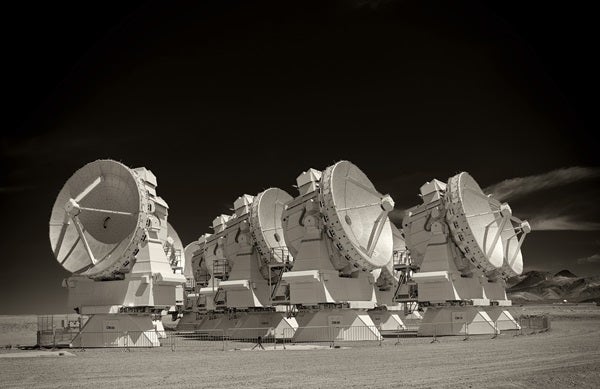Nearly 30 years ago, the world’s top radio telescope engineers and black-belt radio astronomers haggled over their requirements for an array of antennas that could investigate the deepest, darkest, and coldest places in the universe better than any other telescope ever made.
What they sought sounded like a starry-eyed wish list: 60 or more antennas able to survive blizzards and 100mph (160 km/h) winds yet also able move as fast as missile trackers. And that’s not all. Their surfaces cannot deform more than a third the thickness of a human hair. Their electronics can’t add noise to the data. Giant trucks must carry the antennas safely for miles across a high-altitude desert without dropping power to the cryogenic receivers. And the array won’t work without a supercomputer that can perform 17 quadrillion operations every second.
Fast forward to 2014, and this seemingly fantastical telescope — the Atacama Large Millimeter/submillimeter Array (ALMA) — is complete. It is a leap in astronomical imaging akin to Galileo Galilei’s first use of a telescope, and similarly, its technology and early science have changed the business of astronomy forever.
Achieving this marvel required the largest ground-based telescope partnership in history, an international collaboration between North America, Europe, East Asia, and Chile that collected $1.3 billion to design and build the world’s most complex astronomical instrument.
Engineering expectations
Radio telescopes gather light with wavelengths from fractions of a millimeter to hundreds of meters. Visible-light waves, by contrast, are only hundreds of nanometers long. Antenna size being equal, a radio telescope’s ability to image the universe is to an optical telescope’s capacity what finger-painting is to a color photograph.
To gather and focus enough radio waves to achieve similar or better resolution than their optical cousins, radio telescopes must be huge. Earth’s gravity limits the immensity of a single telescope, but ingenuity can counter that force.
The world’s most versatile radio telescopes are built as reconfigurable arrays of antennas, affording them maximum power and flexibility. Special-purpose supercomputers pair the data from each antenna with that from every other antenna across the array — in some cases, up to thousands of miles away — to create binocular images of the sky from many different perspectives. The farther apart two antennas are, the greater the resolution of their binocular vision. This groundbreaking technique is known as “aperture synthesis” and won a Nobel Prize for its pioneer, Sir Martin Ryle.
The resulting data provide often unequalled detail — measurements that precisely reveal the spectra (emission of different wavelengths of light), shapes, positions, and distances — of objects in space. ALMA, its 66 antennas spread a maximum distance of 9.9 miles (16 kilometers) apart, will have 10 times the resolution of the Hubble Space Telescope when the antennas are observing at their smallest wavelengths.
Unlike its shorter-wavelength cousins, such as Hubble, that collect light as energy packets that hit detectors and form pixels in an image, ALMA must process the light it collects as waves. Each ALMA antenna surface has been painstakingly hand-tuned to accurately reflect light waves as tiny as 400 micrometers long — that’s about the length a human hair grows in a day. If the dishes have bumps any larger than one-third the diameter of a human hair, then the cosmic waves are scattered away.
Also, submillimeter light waves crash into ALMA’s receivers at frequencies as high as the terahertz range — 1 trillion per second — and no computer (yet) can handle a data stream like that. Therefore, all signals exiting ALMA’s receivers have to be mixed with a longer carrier wave. A metronome-like device (called a local oscillator) sends this “beat” to each antenna.
To ensure these electronics do not introduce any signals of their own during the mix-down process (which electronics naturally do), engineers designed innovative, near-microscopic mixers that can be kept cryogenically cold. To reduce other noise, all eight receivers inside an ALMA antenna chill together in a giant thermos that contains 4-kelvin (–452° Fahrenheit) liquid helium, which is bolted behind the dish. This technology has increased receiver sensitivity on Earth fourfold.
The antennas themselves are high-tech art in motion. Engineers from nearly every time zone on Earth came up with three different but equally elegant solutions to the ultimate 12-meter antenna wish list, and the array is an international family of these triplets. Although they look slightly different, ALMA’s antennas all share the record-breaking capabilities that astronomers dreamed up 30 years ago.
ALMA’s state-of-the-art antennas have been assembled at the observatory’s high-tech, high-altitude village in the Atacama Desert of northern Chile. So far, all 66 of its 100-ton (91 metric tons) antennas have completed testing. Once they pass engineering exams, workers haul them 27 miles (43km) deeper and more than 6,000 feet (1,830 meters) higher into the Andes — up to the array’s high-altitude observing site, the Chajnantor Plain. Together, the 66 antennas will gather as much light as a single telescope with a 60,800-square-foot (5,650 square meters) surface.
At 16,500 feet (5,030m) above sea level, the Chajnantor Plain is an otherworldly landscape. The ring of extinct volcanoes that made this ancient lava bed still looms over it today. The largest of them, Licancabur, is a perfect cone that wears a white peak in winter, a superb contrast to the pinks and browns of the undulating plain. While the area is too high for trees, a few scrappy plants manage to flower in crevices that trap morning dew.
In the plain’s center, ALMA’s white-armored antennas are eerily quiet as they tilt and spin in unison under the Atacama’s indigo skies. When astronomers reconfigure the array for different science needs, each antenna is lifted onto a 28-wheeled, U-shaped transporter and gently hauled among the 192 antenna control pads, which are linked by a 10-mile-wide (16km) Nazca-like spider road system carved into the dust. At the technical building, which features a mirrored-glass front, air locks separate a bus-sized, blinking supercomputer from the half-pressure landscape. A Star Trek away team wouldn’t not look out of place here.
The science buster
Radio astronomers can open an array telescope for science business when only a fraction of the antennas are in situ. As the array grows, its abilities increase, as do its challenges. Despite having only 55 of its 66 antennas in operation at the time, ALMA was officially inaugurated March 13, 2013.
Well before the president of Chile signaled that the array could begin its operations phase, scientists from around the world clamored to be the first to use this powerful telescope. All together, they requested nine times as many hours as ALMA could actually offer.
Why do so many astronomers want to use ALMA? Because they know that ALMA was built to make — but more likely break — science. Like aerogel, science is rigid enough to support solid theories but fragile enough to crumble under an onslaught of contradictory, reproducible data. ALMA’s leap in telescope technology makes it the fastest, most detailed eye on the secret happenings of the universe, and that means it will discover things beyond our imagination.
Just more than 100 projects were awarded observing time during the intial research cycle. The results from the telescope’s first historic observations are tearing out the pages of astronomy and chemistry textbooks and replacing them with theory-shattering new science.
ALMA was built to look at cold stuff, including molecules and particles that are barely moving and have just enough oomph to spritz out detectable photons with energies just below those of infrared light — the millimeter and submillimeter waves.
Truth be told, the universe keeps some of its best secrets on ice. The average cosmic get-together of gas and dust known as a molecular cloud, for example, registers at around 10–20 K (–442° F to –424° F), barely above absolute zero. There, atoms huddle together, forming molecules that shiver at the wavelengths that ALMA detects. These molecules crowd into clouds that then draw together gravitationally to form denser clumps. Trillion-mile-wide masses compress further to form stars and planets.
To optical telescopes, these early stages of star formation are hidden behind the curtains of dense clouds. Until a star is actually born in such a nursery, infrared telescopes also have little view of what’s going on in there. Radio telescopes, however, see through the dust blankets that swaddle young star systems to the clouds whirling within. ALMA and other millimeter/submillimeter telescopes map and clock the particles that flow onto and grow the baby stars and planets, essentially surveying the construction sites of future worlds.
Rustling up some gaseous grub
With every young solar system ALMA observes, the flip book of star and planet formation changes. Astronomers have been trying to fill in the story of how nascent stars stop growing after planets begin to hoard material from the disks of gas and dust.
To hunt for an answer, scientists aimed ALMA at the young star system known as HD 142527. There, they caught a touching snapshot of a single-parent family pulling together. Two planets orbit the star inside its rich disk of material. ALMA saw rivers of gas and dust flowing in a surprising direction — from the baby planets toward their young parent sun.
ALMA’s velocity data show not only that the massive planets’ greediness yanks on gas and dust in the disk, hurling it toward them, but also that it does so at such speeds that some material overshoots the planets and falls into the growing central sun. In other words, planet formation actually helps star formation.
Astronomers also use ALMA to investigate the ingredients that mix together to form stars and planets. During a recent look at the disk orbiting the young star TW Hydrae, ALMA showed planetary geologists a critical scene in planet building: the location of the so-called snow line.
Among the many gas molecules around this red dwarf star are carbon monoxide (CO) and diazenylium (N2H+), some of chemistry’s lousiest neighbors. In a cloud of molecules, CO destroys N2H+. So when ALMA discovered a sudden abundance of N2H+ in the disk, a chilly 3 billion miles (4.8 billion km) from the star, scientists realized that the CO must have frozen onto dust particles, leaving N2H+ safe from annihilation.
This is great news for planet spotters because CO-ice-covered grains are sticky, and they fasten to each other like Velcro to make larger objects, such as comets, asteroids, and even planets. ALMA marked the definitive distance around TW Hydrae where icy bodies could form. Although TW Hydrae is smaller than our Sun, it is similar enough to make it a great classroom for scientists studying the origin of our solar system.
Searching for life’s molecules
Fingerprinting molecules in space is also a major goal for ALMA, and it benchmarked many of the requirements for the telescope’s high resolution and sensitivity. Radio telescopes have led this field of astrochemistry for decades, with the giant Green Bank Telescope (GBT) in West Virginia topping the list of astromolecule sniffers.
ALMA recently found the signal of a simple sugar called glycolaldehyde in the young star system IRAS 16293–422. Glycolaldehyde is a building block of RNA, a cousin of DNA, and a major mover of genetic information inside (and in the case of viruses, into) a cell. The GBT previously detected this critical prebiotic molecule in a molecular cloud, but ALMA now has found it falling into the future planet-making zone around a young Sun-like star. As radio telescopes continue to discover life-building molecules in space, the line between astrochemistry and astrobiology will continue to blur.
More earths than imagined
Chemical and biological examinations may be relevant in even stranger circumstances. ALMA ripped out more pages of planet-formation textbooks when its antennas turned toward the brown dwarf Rho Ophiuchi 102, an object 60 times larger than Jupiter but not big enough to fuse hydrogen in its core.
After about an hour staring at this room-temperature object, ALMA saw the surprising signals of dusty grains peaking up through the noise. Surrounding this brown dwarf is a cold, thin disk of particles that may be forming an Earth-like planet.
Cue the dramatic music: An object that can’t gather enough material to compress its core and shine like a star shouldn’t have enough material around it to form a planet. And yet ALMA sees the making of a small world. Perhaps, as with the revolutionary Kepler mission, ALMA will show us that Earth-sized extrasolar planets are quite common and appear in more unexpected places.
For every planet that is born, many stars must die. Stars made (and still make) all elements larger than beryllium, so our world and even our bodies were built with the molecular bricks of ancient suns. Catching the scent of their dusty refuse is another of ALMA’s specialties. Recently, ALMA presented scientists with a conundrum regarding the molecular mess around fan-favorite Supernova 1987A — the remnant of a blue supergiant star that exploded, very publicly, in the Large Magellanic Cloud. The blast’s light reached Earth in 1987.
Telescopes of every variety stalk SN 1987A to record how it has evolved since then. Science paparazzo have learned and then unlearned much about stellar evolution by watching the star’s innards plow into space.
New data from ALMA revealed that an unbelievable amount of carbon dust is forming at this young supernova site. There is as much carbon accumulating in the remnant as the star could have created during its fusion phases.
What if ALMA observes SN 1987A in the future and finds even more carbon freezing out of the remnant, more than the star should have been able to make? Be horrified or tantalized, but the consequences of such a discovery would mean tossing out classic textbook versions of stellar nucleosynthesis, chemistry, and/or dust formation models.
Galactic ménage à trois
ALMA can detect the signals of carbon clearly across the universe. Looking more 12 billion years into the past, the array recently watched a trio of bright objects doing shocking things.
Three galaxy-sized clumps of gas and stars crowd together in a giant bath of atoms ionized by the energy of fervent star formation. Discovered by the Subaru Telescope as a single bright object at the edge of the universe, it is named Himiko after a mysterious Japanese queen. Thanks to the Hubble Space Telescope, scientists now have details showing that three distinct bright islands actually shine within Himiko.
If these galaxy clumps are mature enough, then supernova explosions should have enriched the gas bath with carbon ashes. Scientists aimed ALMA at this distant scene to determine if the frolickers were of age. Nope: ALMA saw no sign of carbon, a surprising indicator that these galaxy-sized objects were caught in the act of making their very first stars — when the universe was only 800 million years old! This discovery breaks the record ALMA set previously for finding galaxies making stars only 2 billion years after the Big Bang.
Nestled so closely, the Himiko gathering is on the verge of a titanic merger, the mechanism by which astronomers think most large galaxies like the Milky Way formed. ALMA’s cosmic voyeurism will help confirm the origins of the big old galaxies we see in the current universe, the same ones we enjoy viewing through backyard telescopes.
Stay tuned for more
These results — and many more — come from observations made with fewer than a quarter of ALMA’s antennas, yet already ALMA is an instrument that challenges theories and pulps textbooks. The exhilarating truth is that we have yet to witness all that the array can and will see when its 66 antennas are working as one.
From watching the births of galactic superstructures to finding the chemistry that could form life, this telescope’s range of science is as vast as the cosmos. ALMA’s engineers have given scientists the ultimate gift to unwrap: the secrets of the hidden universe.

